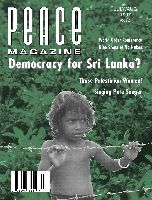
Peace Magazine Jul-Aug 1997, page 16. Some rights reserved.
Search for other articles by Cheshmak Farhoumand here
Toronto was the city of choice for this exciting conference held June 6-8 at Ryerson Polytechnic University's Oakham House. The event brought together academics, activists and practitioners from diverse backgrounds for lively and informative discussions, and participants enjoyed meeting old and new friends. It was sponsored by Science for Peace, Ryerson Polytechnic University, Soka Gakkai International (SGI) Canada, the U.N. Association of Canada (Toronto), the International Society for Systems Sciences, the Millennium Council and the Voice of Women for Peace.
The main objective of the conference was to examine world order from a historical perspective, tracing early use of military forces to the development and implementation of international law and global organization in this century. Dr. Anatol Rapoport, Professor Emeritus at the University of Toronto, set the foundation for the conference with an eloquent keynote address on European history and Kenneth Boulding's three systems of world order, "Coercion, Exchange and Integration." Other participants moved on to discuss their visions of peace and the roles of government, NGOs, corporations and individuals in transforming society both locally and globally.
Topics discussed included military and NGO peace initiatives, the environment, culture, migration, education and economics. There were also talks on ethics, religion, and spirituality offered from various perspectives, including Buddhist, Christian, Native, and Baha'i.
With the end of the Cold War and the outbreak of intra-state conflicts based on nationality, ethnicity, and religion, the international community is realizing that conventional diplomacy is not successful when applied to these intractable conflicts.The challenge to diplomacy was exacerbated by international law upholding the rights of states to sovereignty and autonomy. We stood "helpless" as images of the tragedies of Rwanda and the former Yugoslavia flashed across our screens, with tears in our eyes and the words "never again" echoing in our minds.
The inadequacy of traditional sources of conflict resolution has resulted in an impressive expansion of the role of citizen diplomats and grass roots organizations, many of which are spiritually motivated. History books attest to the potentially divisive and destructive character of religion, yet history has taken a different turn in modern day international affairs.
D. Johnson and C. Sampson, authors of Religion: the Missing Dimension of Statecraft, discuss in elaborate detail the contributions of different religious communities in reconciling people trapped in conflicts.1 On an informal basis, religious and spiritual values have an immense relevance to reconciliation processes and act as a potent force in encouraging peaceful resolutions.
Jimmy Carter, the catalyst for the Camp David Accords which brought together the leaders of Israel and Egypt for a historic peace initiative, believes religion and spirituality had an impact on the negotiations. He remembers that a joint appeal for prayer preceded each discussion, and each of the three leaders also worshipped separately throughout the meetings. The participants were convinced that peace is a gift from the Creator and a preeminent human obligation. The role of religion and spirituality is also evident in other peace processes, such as in the Zambian Case (1993), in Nicaragua, and most profoundly in the Franco-German reconciliation after WWII.
At "The Evolution of World Order" Conference, two sessions were dedicated to religious, spiritual, and ethical issues. The presentations were followed by lively discussions in which commonalities were noted by many. These two sessions confirm that religion and spirituality need be discussed so that they can be a unifying, rather than divisive, force for peace.
The last day was spent at Soka Gakkai's beautiful Caledon Centre for Culture and Education. Participants divided into working groups to create the Caledon Declaration, a document to be published and distributed widely to government and international organizations. The conference ended with a tree planting ceremony, where each participant drew inspiration and conviction to contribute to the transformation of the world from one of war and division to one of peace and unity.
1 D.Johnson & C. Sampson Religion: the Missing Dimension of Statecraft. New York: Oxford University Press, (1994). p. vii.
Cheshmak Farhoumand is a Baha'i who recently earned a masters degree in conflict analysis and resolution.

Peace Magazine Jul-Aug 1997, page 16. Some rights reserved.
Search for other articles by Cheshmak Farhoumand here